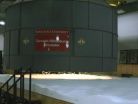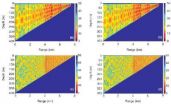(Press-News.org) AMES, Iowa – Christopher Karstens was on the ground studying the damage caused by the deadly April 27, 2011, tornado that hit Tuscaloosa and Birmingham, Ala.
It was just a week after the tornado. He was between the two cities, in the rough country of the southern Appalachians about 20 miles northeast of Tuscaloosa. He said it's terrain that's "beyond hilly." It's covered by dense forest and clogged by high brush that's tough to walk through. A hike of about 100 yards sometimes took as long as 45 minutes.
It was a perfect place for Karstens – a doctoral student from Atlantic who's studying under the direction of Bill Gallus, a professor of geological and atmospheric sciences – to study the effects of complex terrain on the structure of a tornado.
The study is part of a larger Iowa State research program led by Partha Sarkar, a professor of aerospace engineering and director of the university's Wind Simulation and Testing Laboratory. The lab includes several conventional wind tunnels and a Tornado/Microburst Simulator that has been fully functional since 2005. The Tornado/Microburst Simulator has helped researchers attract about $2.3 million from the National Oceanic and Atmospheric Administration and $580,000 from the National Science Foundation to study the impacts of tornado and microburst winds near the ground and their effects on buildings and other structures. One goal is to develop innovative ways to make structures, particularly low-rise buildings, stand up to tornadoes, hurricanes, gust fronts and microbursts from thunderstorms.
Iowa State's tornado research teams have included Sarkar; Gallus; Hui Hu and Vinay Dayal, associate professors of aerospace engineering; Fred Haan, an associate professor of mechanical engineering at the Rose-Hulman Institute of Technology in Terre Haute, Ind., and former aerospace engineering faculty member at Iowa State; Sri Sritharan, professor of civil, construction and environmental engineering; and Gene Takle, professor of agronomy and geological and atmospheric sciences.
"We've learned a lot in terms of the distribution of wind and in terms of the interaction of wind with structures and terrain," said Sarkar.
Sarkar said the researchers have found, for example, that when a tornado blows over rough terrain – forests or densely built cities – the structure of the tornado changes. The swirl and maximum rotational speed of the tornado decrease and the vortex spins tighter with a smaller core.
Karstens took that study further by looking at what happens to a tornado when it hits complex terrain such as cliffs, slopes and valleys. That's why Karstens joined other researchers studying the damage caused by the Tuscaloosa-Birmingham tornado.
The researchers looked at the damage to homes and buildings in the cities – part of their work to develop structures that can withstand high winds. Then Karstens headed for the hills to study the damage there.
He hiked to the storm path and noted damage on the ground and in the trees. He looked for signs that the terrain had disrupted the tornado as it moved up and down the steep slopes. He hiked to the top of valleys so he could take pictures of the damage below.
Back in Ames, he also studied aerial photos of the storm damage. That's when he noticed that trees along valleys far from the tornado path were damaged by high winds.
Karstens returned to the area last January for a second and closer look at specific locations he had identified. He looked at how the damage changed as the storm moved up and over the low mountains. He studied how root and soil conditions could have influenced the storm damage. And he explored side valleys perpendicular and to the left of the tornado's path to see the storm damage he noticed on the aerial photographs.
"It was very beneficial to go," Karstens said. "By physically observing the damage I could identify the situation, use some intuition and interpret what happened. That can lead to new ideas and thoughts."
One thought he took back to campus is that the perpendicular valleys provided a channel for the high winds and kept them going far from the actual tornado.
To test the theory, Karstens built a 32-foot by 20-foot 3-D foam replica of a 2-mile by 3-mile section of the same Alabama countryside he explored on foot. Then he ran Iowa State's Tornado/Microburst Simulator over the model terrain, taking wind readings inside the various valleys.
Karstens, who has accepted a research job at the Cooperative Institute for Mesoscale Meteorological Studies in Norman, Okla., is still analyzing the data. But he thinks he's onto something new.
"For meteorology, this can add another piece to the puzzle," he said. "It can help us understand the near-surface flow of winds in tornadoes."
INFORMATION:
Contacts:
Partha Sarkar, Aerospace Engineering, 515-294-0719, ppsarkar@iastate.edu
Bill Gallus, Geological and Atmospheric Sciences, 515-294-2270, wgallus@iastate.edu
Christopher Karstens, Geological and Atmospheric Sciences, 641-750-1772, ckarsten@iastate.edu
Mike Krapfl, News Service, 515-294-4917, mkrapfl@iastate.edu
Iowa State researchers find, test winds extending far away from Alabama tornado's path
2012-04-10
ELSE PRESS RELEASES FROM THIS DATE:
Loyola study debunks common myth that urine is sterile
2012-04-10
MAYWOOD, Ill. -- Researchers have determined that bacteria are present in the bladders of some healthy women, which discredits the common belief that normal urine is sterile. These findings were published in the April issue of the Journal of Clinical Microbiology by researchers at Loyola University Chicago Stritch School of Medicine (SSOM).
"Doctors have been trained to believe that urine is germ-free," said Linda Brubaker, MD, MS, dean, SSOM. "However, these findings challenge this notion, so this research may have positive implications for how we treat patients with ...
PINC Solutions Named "Cool Vendor" by Leading Analyst Firm
2012-04-10
PINC Solutions, the leading provider of advanced yard management systems (YMS) today announced that the company has been included in the list of "Cool Vendors" in the Supply Chain Management report by Gartner, Inc.
According to the March 26, 2012 report, this year's "Cool Vendors" prove once again that, although aspects of the SCM technology market are mature, innovation continues as companies look for capabilities that make them more competitive or improve their operating metrics.
Traditionally, yard management has been looked at as a means to ...
Consumerism and its antisocial effects can be turned on -- or off
2012-04-10
Money doesn't buy happiness. Neither does materialism: Research shows that people who place a high value on wealth, status, and stuff are more depressed and anxious and less sociable than those who do not. Now new research shows that materialism is not just a personal problem. It's also environmental. "We found that irrespective of personality, in situations that activate a consumer mindset, people show the same sorts of problematic patterns in wellbeing, including negative affect and social disengagement," says Northwestern University psychologist Galen V. Bodenhausen. ...
Cancer patients prefer risky treatments with larger rewards to 'safe bets'
2012-04-10
A new analysis provides a closer look at how much cancer patients value hope — with important implications for how insurers value treatment, particularly in end-of-life care.
The analysis led by Darius Lakdawalla, director of research at the Schaeffer Center at USC and associate professor in the USC Price School of Public Policy, surveyed 150 cancer patients currently undergoing treatment, and is part of a special issue on cancer spending from the journal Health Affairs.
Lakdawalla and his co-authors found the overwhelming majority of cancer patients prefer riskier ...
800-year-old farmers could teach us how to protect the Amazon
2012-04-10
In the face of mass deforestation of the Amazon, recent findings indicate that we could learn from its earliest inhabitants who managed their farmland sustainably. An international team of archaeologists and paleoecologists, including Dr. Mitchell Power, curator of the Garrett Herbarium at the Natural History Museum of Utah and assistant professor in the Department of Geography at the University of Utah, report for the first time that indigenous people, living in the savannas around the Amazonian forest, farmed without using fire. These findings are published today, April ...
More exercise, eating less fat and weight loss programs are in, popular diets are out
2012-04-10
BOSTON – Contrary to popular perception, a large proportion of obese Americans can and do lose weight, say researchers at Beth Israel Deaconess Medical Center. What's more, they say, the old tried and true methods of eating less fat and exercising are some of the most effective paths to weight loss success.
The research results appear in the April 10 online issue of the American Journal of Preventive Medicine.
"This is great news because studies have shown that even a 5 percent reduction in weight can lead to improved health," says lead author Jacinda M. Nicklas, MD, ...
Researchers identify successful strategies for weight loss in the obese
2012-04-10
San Diego, CA, April 10, 2012 – A third of Americans are now obese, and up to 70% of them are trying to lose weight. In a new study published in the American Journal of Preventive Medicine, researchers from Harvard Medical School and Beth Israel Deaconess Medical Center in Boston have found in a nationally representative sample that obese dieters who said they ate less fat, exercised more, and used prescription weight loss medications were more likely to lose weight. Diet foods and products, nonprescription diet pills, and popular diets were less successful, according ...
Frequent dental X-rays linked to most common brain tumor
2012-04-10
People who received frequent dental x-rays in the past have an increased risk of developing the most commonly diagnosed primary brain tumor in the United States. That is the finding of a study published early online in Cancer, a peer-reviewed journal of the American Cancer Society. Although dental x-rays are necessary in many cases, these findings suggest that moderate use of this form of imaging may be of benefit to some patients.
Ionizing radiation is the primary environmental risk factor for developing meningioma, which is the most frequently diagnosed primary brain ...
An efficient method for solving sound propagation in range-dependent ocean waveguides was found
2012-04-10
The coupled normal mode method is a powerful approach for solving range-dependent propagation problems in underwater acoustics. An important area of study is to improve stability and efficiency so as to be able to deal with complex scenarios in a realistic environment. Professor LUO Wenyu and his group from the State Key Laboratory of Acoustics, Institute of Acoustics, Chinese Academy of Sciences, set out to tackle this problem. After several years of innovative research, they have developed an accurate, efficient, and numerically stable coupled normal mode method to solve ...
Healthcare's Elite to Meet and Compete for Inaugural National Championship
2012-04-10
The Pharmaceutical Education and Research Institute (PERI) and PeerParty are pleased to announce the inaugural CME National Championship for the healthcare community. The Championship introduces a new approach to continuing education for healthcare practitioners - a fun, collaborative approach that rewards participants for learning and building their professional networks. This innovative approach employs a number of new techniques to challenge and reward participants, with the goal of positively affecting knowledge-sharing, learning and most importantly, improving patient ...



